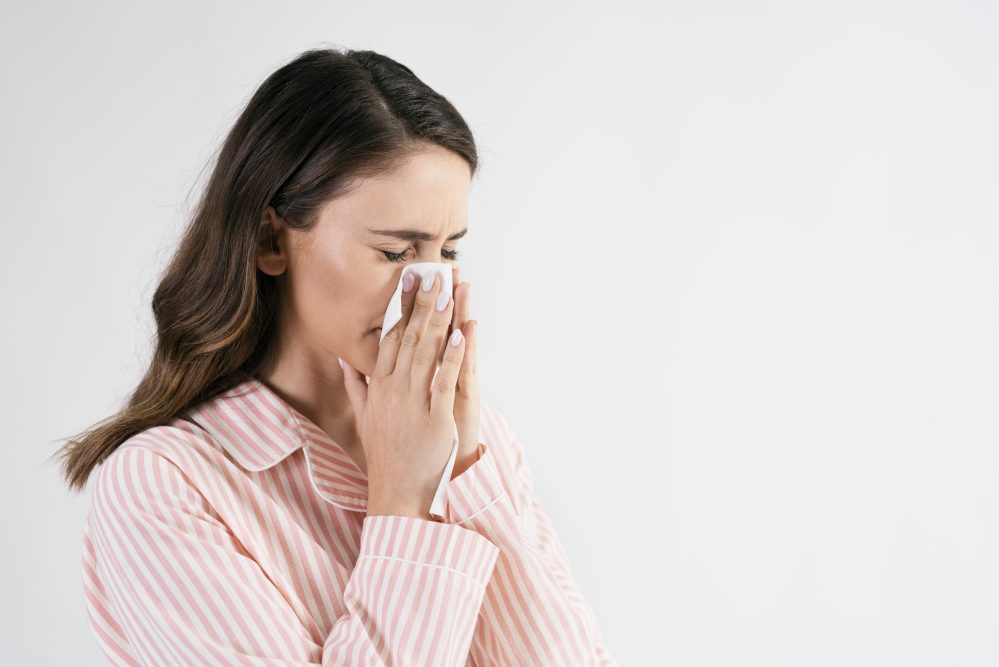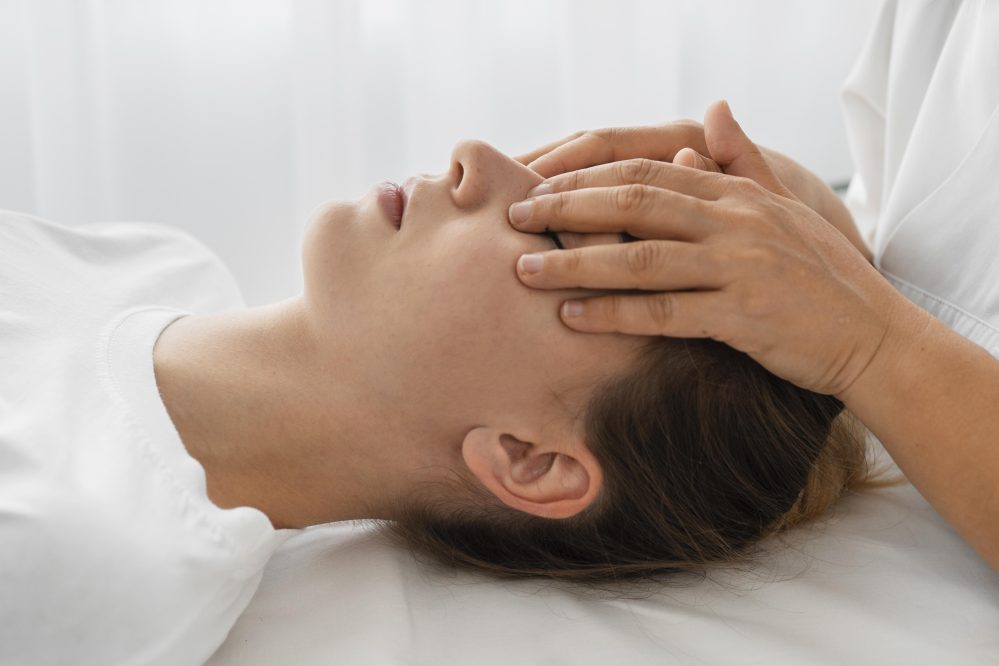You might’ve heard of sinuses before, but are you aware of their critical significance in many functions essential to well-being? As narrow cavities interconnected in the face and skull, sinuses navigate the production and movement of mucus and help prevent various infections.
However, like other bodily systems, the sinuses can become infected when attacked by viruses, bacteria, or fungi, necessitating the search for a remedy. In such cases, understanding the importance of acupressure as an alternative healing approach can be your gateway to reducing pain.
Whether you’re facing congestion, headaches, or sinus discomfort, this comprehensive guide will equip you with the knowledge to harness the healing potential of sinus pressure points. Say goodbye to sinus woes as we unravel the key acupressure points for effective pain relief!
What Are Sinuses?
Sinuses are air-filled cavities or spaces in the face. They are lined with a mucous membrane and connected to passages in the nose. Sinuses play a role in producing mucus, which is the slippery fluid that contains protective immune cells and runs through the nose. This process helps remove bacteria, allergens, dust, and other irritating particles to prevent infection.
Types of Sinuses
There are four main types of sinuses located in the face, and each corresponds to a specific bone which they are named after. Sinuses are important for many reasons, including their effect on lightening the weight of the skull and protecting it from trauma, modifying the voice tone, and producing mucus. Nevertheless, their function continues to be a subject of study.
The four types of sinuses are:
Frontal sinuses – Located in the frontal bone (forehead bone) above the eyes.
Maxillary sinuses – Situated in the maxillary bone (cheekbone) on either side of the nose. These are the largest sinuses.
Ethmoid sinuses – Found between the eyes and behind the nasal bridge in the ethmoid bone.
Sphenoid sinuses – Located behind the ethmoid sinuses, deep within the skull, and behind the eyes.

Sinus Infection and Symptoms
When microorganisms enter the sinuses, it often leads to a sinus infection known as sinusitis. This causes inflammation of the tissue layering the sinuses, thus giving rise to various symptoms. Sinusitis is most common after a cold or flu, and it can be acute and chronic. While both are manifested through similar symptoms, chronic sinusitis lasts much longer.
Common symptoms associated with sinusitis are:
– Stuffy or runny nose
– Pressure in the face – particularly in the nose area
– Headache – concentrated in the forehead
– Cough
– Fever – not common with chronic sinusitis
– Fatigue
– Reduction of taste and/or smell
– Bad breath
Various remedies, prescription medications, and alternative techniques can help ease the intensity of these symptoms. Many individuals find acupressure effective for pain relief from sinusitis, though scientific evidence is still evolving.
Sinusitis can also be treated by:
– Taking painkillers to alleviate pain and reduce inflammation
– Avoiding allergic triggers that may contribute to sinusitis
– Resting to support the immune system
– Drinking enough fluids to help thin mucus and promote drainage
– Rinsing your nose to flush out mucus and irritants

What Is Acupressure?
Acupressure is a healing technique often used in conjunction with the acupuncture treatment. It employs pressing the acupuncture body points to regulate the flow of “qi” (energy) along meridians and alleviate pain naturally. This helps promote the release of endorphins and neurotransmitters that contribute to pain relief.
As an alternative technique, acupressure comes from Traditional Chinese Medicine (TCM) and is similar to acupuncture; the main difference is that acupuncture uses needles, whereas acupressure is performed with fingers, hands, arms, or hand rollers.
Acupressure as a holistic approach has demonstrated significant effectiveness in resolving many health conditions, which resulted in the practice of acupressure in Western medicine. Similarly, acupressure is used to treat problems associated with sinuses, including sinusitis, by applying firm pressure in specific areas recognized as sinus pressure points.
Along with pain relief, acupressure contributes to stress reduction and relaxation, and promotes well-being. However, when facing serious issues, consulting with a healthcare professional for proper diagnosis and treatment is recommended.
What Are Sinus Pressure Points?
Sinus pressure points represent specific areas in the body that are believed to correspond to specific sinuses and are used during acupressure for sinus pain relief. One can stimulate these points at home by applying pressure using one’s fingers. It’s important to do so in circulatory movements or up and down.
According to TCM, stimulating these points can help alleviate pain and symptoms resulting from sinusitis or sinus congestion. While scientific evidence supporting the effectiveness of acupressure for sinus relief is limited, some people find it a complementary approach for managing sinus issues.
11 Sinus Pressure Points for Relief
Understanding various sinus pressure relief points is key to reaching positive results in acupressure. One must know where the main points are located and which sinuses they’re connected to. This will help tailor acupressure to treat specific conditions.
Here are the 11 most important sinus pressure points for pain relief:
- Governor Vessel 24.5 (GV 24.5) is located on the forehead, between the eyebrows. It is also known as the Third Eye. Stimulating this point is great for mucus drainage and headache relief.
- Bladder 2 (BL 2) is centered on the nose ridge, close to the inner corners of the eyes. Applying pressure to this point will affect sinus congestion and headaches and relieve pressure around the eyes.
- Large Intestine 4 (LI 4) is one of the hand points located on the back of the hand, specifically in the area between the thumb and index finger. Pressuring this point will ease sinus pain and headaches and release muscle tension.
- Large Intestine 19 (LI 19) can be found between the nostrils and the upper lip. Rubbing this point helps with nasal congestion and swelling and treats jaw disorders.
- Large Intestine 20 (LI 20) is situated on both sides of the nostrils. This pressure point is effective for swelling and other symptoms related to sinusitis.
- Stomach 3 (ST 3) is symmetrical to the area below the pupils and in line with the bottom of the nostril. It is targeted to alleviate sinus and dental pain and facial paralysis.
- Small Intestine 18 (SI 18) is situated in the hollow part of the cheekbone on the outer edge of the nose. Massaging this point helps with swollen sinuses and runny noses.
- Gallbladder 20 (GB 20) can be found on the back of the head, where the neck meets the skull. One should apply pressure to this point to relax the muscles and reduce neck pain. It is also thought to help with migraines.
- Lung 5 (LU 5) is located on the crease of the elbow. Stimulating LU 5 may help relieve a runny nose and treat respiratory issues, including coughing, sore throat, and abdominal pain.
- Lung 9 (LU 9) is located at the end of the wrist crease, under the thumb. Since it’s believed to be connected to the lungs, it can help with colds, asthma, and sinus infections.
- Liver 3 (LV 3) is situated on the groove between the big toe and index toe. Stimulating the LV 3 point helps reduce pain around the eyes, headaches, and stress.
When to Seek Medical Attention
While acupressure can offer temporary relief from sinus pressure and pain, severe conditions and symptoms associated with sinus problems should be treated by a doctor. It’s crucial to schedule an appointment if you’re experiencing at least one of the following:
– Prolonged sinusitis
– High fever
– Intense headache or facial pain
– Visual impairment or eye symptoms
– Difficulty breathing
– Neck stiffness or neck pain
Though the occurring symptoms are usually all-embracing, remember that individual experiences can vary. Should you feel uncertain about the severity of your symptoms, please seek immediate medical attention and guidance!
Conclusion
Sinuses, the air-filled cavities within the skull and face, are critical in lightening the weight of the skull, offering resonance to the voice, and producing mucus. When inflamed, sinuses can cause many symptoms. Understanding key sinus pressure points is vital for individuals grappling with common sinus infections and symptoms. If you’re dealing with sinusitis or encountering other sinus-related issues, consider exploring acupressure as a potential solution. Employing the knowledge of sinus pressure relief points we’ve shared could serve as your pathway to effective pain relief!
Frequently Asked Questions (FAQs)
Does sinus pressure point stimulation work?
While the effectiveness of acupressure is backed up scientifically, many individuals claim that stimulating sinus pressure points helps reduce sinus infection, headaches, and nasal congestion.
Can you do acupressure for allergies?
Yes, acupressure can be utilized as a complementary approach for managing allergy symptoms. Stimulating specific acupressure points related to the respiratory system and immune function may help alleviate congestion, reduce inflammation, and promote overall well-being.
Is heat or cold better for sinus pressure?
Both heat and cold can provide relief for sinus pressure. Still, choosing between them often depends on preference and the specific symptoms.
Can sinus pressure cause dizziness?
Yes, sinus pressure can cause dizziness. When the sinuses become inflamed or congested, it can affect the balance mechanisms in the inner ear, leading to feelings of dizziness or lightheadedness.

